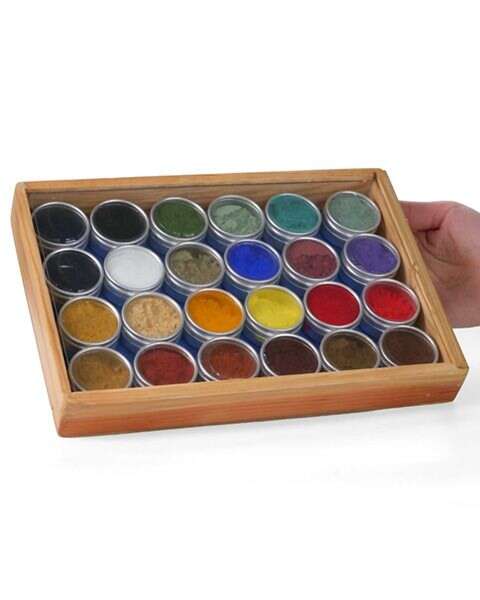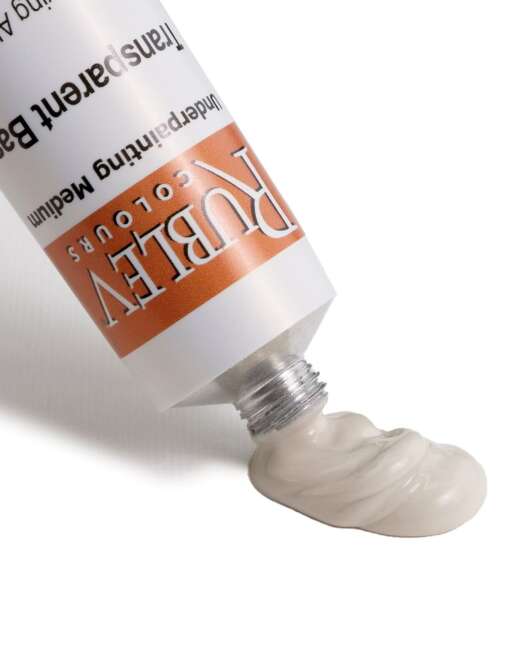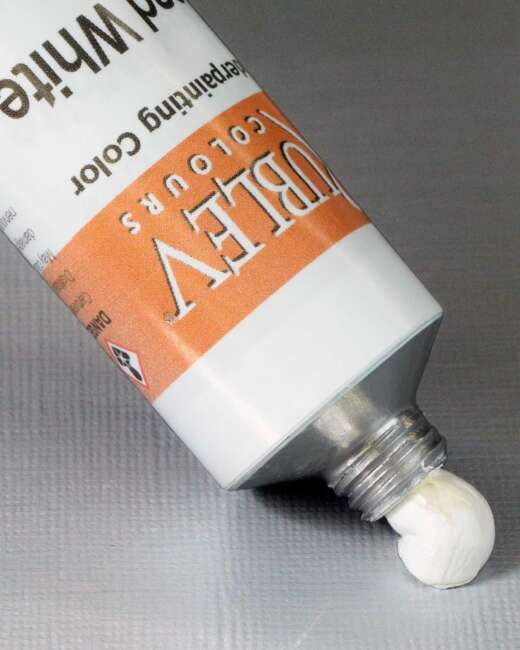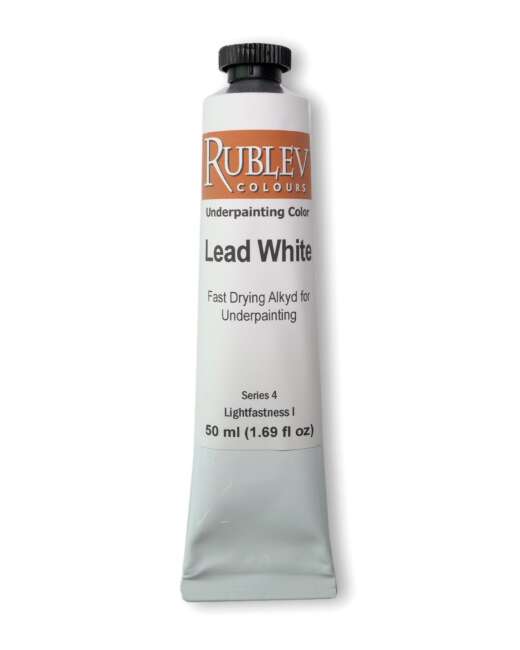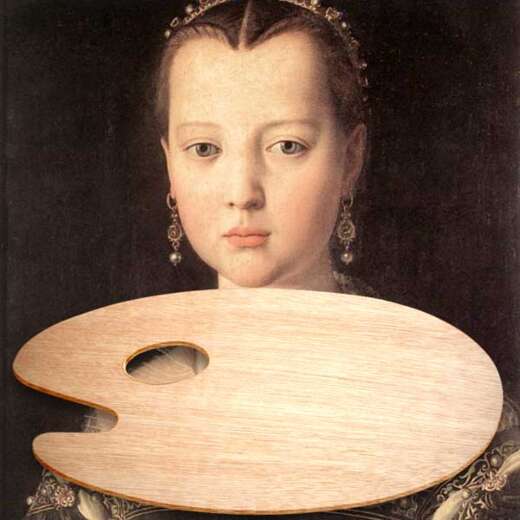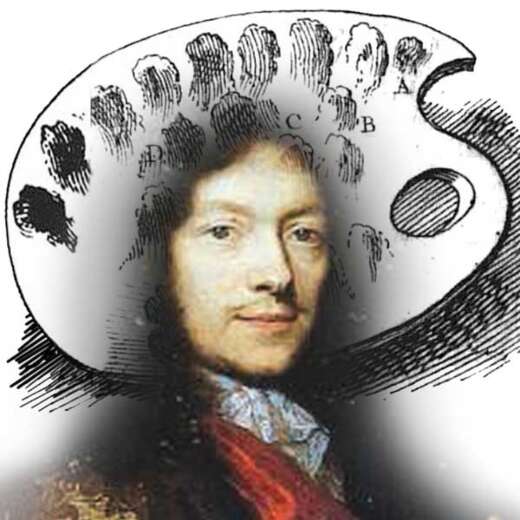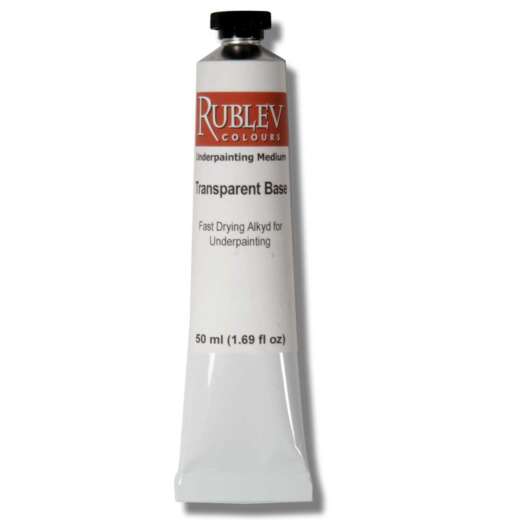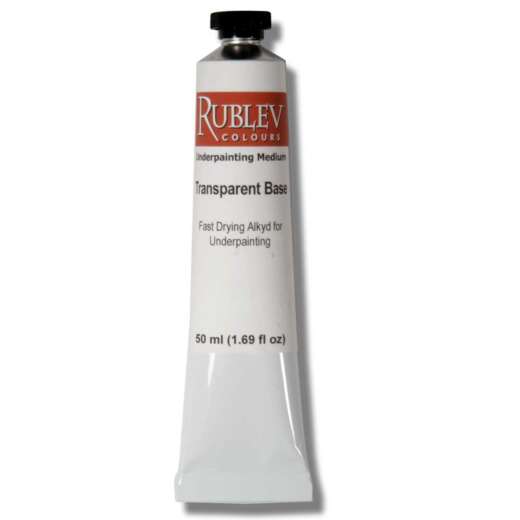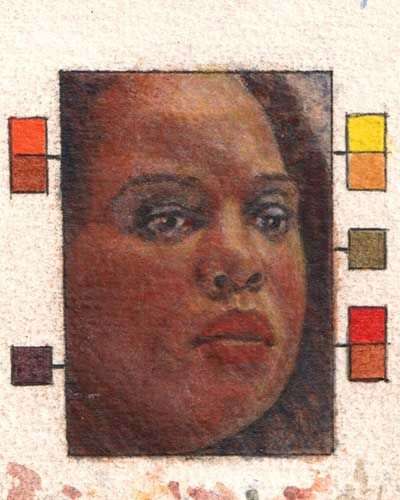Sankir—Underpainting of Flesh, Part 2

This is the second part of the introduction to the underpainting of faces and flesh—sankir in Russian and proplasmos—in Greek medieval icon painting.
Sankir in Eastern Christian Painting of the Ninth through the Thirteenth Centuries
Usually, the process of constructing painted faces in Eastern Christian paintings of the 9th through the 13th centuries is reduced to the following steps:
Step 1: Draw the cartoon and grafi (18) on the ground (19).
Step 2: Paint an overall tone of flesh color (20) throughout all areas of the face and body parts over the cartoon on the ground. This tone is sufficiently bright (21), reducing the need for prolonged modeling with a highlighting tone, which forms the widest areas of the face. (22)
Step 3: Apply a reddish-brown pigment, darker than the proplasmos (sankir) and consisting basically of red ochre, prasinus [Editors note: For a thorough discussion about this color, see the previous article]. and cinnabar, in a thin transparent coat on the primary shadows: in the eye sockets, along the shaded sides of the nose, mouth, chin, on the folds of the forehead and the neck, on the outline of the face, and so forth. (On the faces of young people, the wide shadows are fairly often painted with warm green earth pigment, such as warm glauconite).
Step 4: Paint the outline of the cartoon — eyes, eyebrows, shaded side of the nose, face, hair, etc. — in black mixed with a small amount of whiting and cinnabar (veneda, i.e., a brownish color — see chapter six of the first book, "The Art of the Painter," in On Divers Arts by Theophilus).
Step 5: Take some cinnabar, mix it with a small amount of a light proplasmos tone and outline the lips, the shape of the nose on the shaded side, and with very dilute color, paint thin glazes on the rouge of the cheeks, forehead, neck, hands, and legs.
Step 6 (last step): Take almost pure whiting and add a small amount of the dominant color or a small amount of cinnabar, orpiment, and dark-blue (lazurite, azurite, or black) and complete the modeling and the whites of the eyes.
Fig. 1. Succession of steps (1–9) in the painting of faces of the 11th-century fresco of Ateni Sion.
This process was at first more complex between the 6th and 8th centuries among the different schools and was later simplified. The 11th-century wall painting from the western apse of the Church of the Dormition of the Mother of God at Ateni Sion (Fig. 1) serves as an example of this simplified painting process:
1. Draw the cartoon with gold ochre on the plaster.
2. Refine the cartoon with red ochre.
3. Paint the overall tone of proplasmos (sankir).
4. Apply paint to the shaded areas.
5. Reinstate the outline and details of the cartoon (first layer).
6, 7. Further reinstate the figure, deepening the tonal value of the shaded areas (second layer) and applying rouge to the cheeks.
8, 9. Add darker tones to the shaded areas (third layer) and paint the final highlights.
An example of a more complex painting method can be seen in the 12th-century fresco of Saint George Cathedral in Old Ladoga, where shadows and highlights were done in two or three steps, beginning with thin transparent glazes that make a smooth passage to the opaque underpainting. Sometimes the color of the first shadows is altered, for example, in the color that is applied to the light underpainting of sankir-proplasmos as the very first modeling of volume instead of thin glazes, and therefore provides light brown modeling. This modeling is applied with an olive or green pigment only after the outlining of eyes, nose, lips, face, etc., is done with a brown pigment (23).
The system described above remained a standard with only small deviations over a long period until the 13th century. It was especially used in frescoes, such as the 13th-century wall paintings of Saint George Cathedral in Achi, and in large icons where the dimensions of faces now and then exceeded the sizes of faces in monumental paintings.
However, by the 11th century, we find in small icons two systems being used within one work, for example, in the icon of the 11th and 12th centuries Saint John Climacus (24) from the Monastery of Saint Catherine on Mount Sinai. The first system is the same as described by Theophilus but considerably simplified because of the small sizes of the faces, and the second is modeled highlights on wide areas of the faces of angels painted over an even-toned light green underpainting. (In this case, apparently, the method is used to isolate the pale angelic faces.) Although it is widely known that the modernized methods generally occur earlier in book miniatures and miniature icon paintings than in monumental paintings, green underpainting (sankir) of comparatively bright tone, although extremely rare, is encountered both in monumental and large-format easel painting as early as the 12th century, such as in the frescoes of Saint Demetrius Cathedral in Vladimir (25) and in the monumental icon of Saint Demetrius of Thessalonica in the collection of the State Tretyakov Gallery, Moscow (26). In these examples, it is feasible to conclude that the masters turned to methods found in the miniature painting developed by iconographers at the Monastery of Saint Catherine.
Besides the cited examples, the green underpainting is usually found only in miniature paintings, such as several miniatures in the Trebizond Gospel of the 10th century. Here it is most noticeable in the miniature of the Evangelist Saint Mark (27) and is used to convey the darkness of his face. In the icons of the Descent of the Holy Spirit (Pentecost) and Descent into Hades of the 12th century from the collection of the Hermitage, Saint Petersburg (28), green sankir is placed "selectively." Namely, in the Descent into Hades, it is located only on the face of Christ and the dark-complexioned face of John the Forerunner. The same method is found in miniatures of the Galitsko-Volinskom Apocryphal Gospel of the end of the 12th century. Here Mark and Luke are depicted as swarthy and dark-haired on a dense green underpainting (sankir), and Matthew and John are white-haired and pale-faced old men on a light-tone underpainting (29). Still more graphical in this sense is the Gospel of Nicodemus of the 13th century. The faces of all its miniatures are painted in the old manner (i.e., over an underpainting of flesh color and green added only to very small areas of shadows). Only the pale face of the raised Lazarus in the miniature of the Resurrection of Lazarus and the dark-complexioned face of the Forerunner in the miniature Christ and the Forerunner are done on a green underpainting.
There are enough examples to make it possible for us to deduce that green underpainting in miniatures of the 10th through 13th centuries was an extremely rare painterly method used to convey the appearance and state of a character, but generally not a common method for painting faces. Typically, almost all paintings in Eastern Christian countries of the 11th through the first half of the 13th centuries still used flesh color as the underpainting with respect to the shadows and modeled highlighting. However, beginning from the second half of the 13th century, in many instances, there appeared deviations from the previous standards—a combination of methods from both old and new systems within the scope of one work. Let us consider the steps in painting faces, for example, in the frescoes of the 12th century Saint George Cathedral in Old Ladoga—made in the old, classical manner of the 11th to 12th centuries—and the painting of faces in the frescoes of the 13th-century church of Saint George in the settlement of lower Achi in Western Georgia.
The sequence of painting in Old Ladoga (Fig. 2, 1–6) follows:
1. The preliminary figure of the face is drawn with deep gold ochre on the white ground.
2. Proplasmos-sankir of a light-tone ochre, close in color and tone to the ochre of a halo, is painted within and overlapping the preliminary figure.
3. Diluted, transparent reddish-brown pigment is used to outline in light brushstrokes the face and to slightly add the shaded form to the shadow side of the nose, upper and lower eyelids, neck, and shadows around the eyes. Shadows are kept small in area, and therefore the bright ocher underpainting of the face remains quite visible.
4. Using the same reddish-brown pigment, only opaque and thicker, make one clean line to draw the eyebrows, eyelids, and pupils of the eyes, nose, mouth, and all face contours.
5. With diluted white pigment (mixed with a small amount of the proplasmos-sankir color), model the forms of the forehead above the eyebrows, nose, cheeks, neck, etc.
6. With lines thinner than the foregoing white highlighting and using thick, almost pure white paint (thick enough so that in oblique lighting, the highlights would appear almost sculptural in relief) complete the painting of the face.

Fig. 2. Succession of steps of painting faces from the 12th-century frescoes in Old Ladoga (Steps I-VI) and the 13th-century frescoes from the Church of Saint George in the lower region of Achi (Steps Ia-VIIIa).
Hair is usually painted as follows: In old people, lay an underpainting of verdure (made with white and glauconite (30)) on the head and beard and, using white mixed with a small amount of the underpainting, apply strokes for the strands of hair; in middle-aged people (for example, the prophet Jeremiah) the underpainting for the hair is composed of reft (Translators note: carbon black or bone black) and white (i.e., a gray color); in younger people, the underpainting for the hair is made with a thin reddish-brown pigment.
All faces in the church of Old Ladoga are painted in this manner, and only on the hands, legs, the outline of jaws, and neck muscles of certain figures in the Apostolic and Angelic ranks and in the cupola composition of the Ascension of Christ are found visible brushstrokes of bright green.
In the Achi frescoes of the 13th century, the majority of faces are painted with the same — although simpler—system that was described for the Old Ladoga frescoes: Light gold ochre, same as on haloes, in the underpainting (proplasmos), reddish-brown outlines and small areas of highlighting (31). Green is not used in this system of painting at all. Nevertheless, many of the large-sized faces (Christ, Mother of God, and John the Forerunner), faces of young people, and female faces in the compositions (32) are done with green shadows as follows (Fig. 2, 1a–8a):
1. With ochre, outline the preliminary figure of the face on the white ground (corrections of the figure are made with red ochre).
2. Use light gold ochre of the same color as halos to lay an underpainting (sankir) over the entire silhouette of the head.
3, 4. Using paint well saturated with green pigment (33) (as the overall tone) develop in comparatively wide areas the shadows of the face: eye sockets, the outline of the nose, contours of the jaw, mouth, and the volume of the neck. The masters of the Achi wall paintings used this technique differently: Some without this shading in the shadows, others with this shading, and sometimes using hatched brushstrokes.
5, 6. Use reddish-brown pigment to outline the eyes, nose, mouth, and entire face.
7. Apply the first layer of highlighting (white pigment mixed with the proplasmos ochre).
8. With fine highlight lines, complete the facial form and whites of the eyes.
The steps in painting hair are the same as in the Ladoga frescoes.
One thing should be mentioned here: The simplification of the painting method and the composition arrangement generally is compensated by the fine judgment of the colorist. Thus, in one of the basic compositions of the Achi wall paintings, the Presentation of Jesus in the Temple, the master of foreign origin influenced by Cappadocian painting traditions of the 12th and 13th centuries (34), painted green shadows only on the faces of the Mother of God and the infant Christ, whereas the faces of other subjects are painted onto the brown outlined figure using a light ochre sankir with a small amount of green added only to harmonize their painting with the coloring of the entire composition.
As far as methods of icon painting are concerned, such icons of the 12th and 13th centuries as the Angel of the Golden Hair of the 11th century (35), Savior of the Golden Hair of the 13th century (36) and the Saints George, John, and Blaise (37), the master not only drew the outlines of the preliminary figure on the levkas using a thinned black pigment, but also developed the shadows, and then overlapped these with an overall tone of transparent flesh color sankir. This method creates a complex color play in the shadows.
However, this system of painting is even more complicated in the icons titled Angel of the Golden Hair, Savior of the Golden Hair, and also in the 13th-century icon of the Savior the Almighty (waist-length) (38). In the deepest shadows of these icons (especially in the eye sockets), the masters made hatch brushstrokes of a dark green color over the proplasmos, typically composed of glauconite, birch wood carbon, and brown earth (goethite). And only after this did they finish the dark figure by adding rouge and highlights (39).
Putting green glazes in shadow areas over the solid tone of sankir-proplasmos almost exactly repeats the painting technique of young persons with green shadows in the church of Saint George in Achi. True, added green glazes in deep shadows do not always exist in Russian paintings of the 13th century. Often these masters were limited to modeling shadows by building a translucent tone with dilute black pigment on the light sankir and levkas, as is evident in three Novgorod icons of the 13th century: Saint Nicholas (waist-length with selected saints in the borders and background) (40), Savior Enthroned (with selected saints in the borders) (41), Saints George, John, and Blaise (42); and two Pskov icons of the 13th century, Prophet Elijah in the Desert (with scenes from his life and Deisis) (43) and the Assumption (from Paromeniy) (44). Although belonging to different schools and being different in their painting complexity and degrees of craftsmanship, all these icons nevertheless are similar according to the principle of defining shadows and highlights on flesh color sankir.
Notes
18. Grafi — scratching the outline of the cartoon on the ground to preserve it through overlapping opaque and dark-toned paint — was not used often. Experienced masters rarely did it.
19. In monumental painting, the figure was defined by brush with yellow ochre. First, it was applied with a very dilute light color. If it was necessary to correct or alter the figure, they continued to draw with a reddish-brown earth pigment called sinopia. Then they covered the cartoon with an opaque layer of sankir (proplasmos); therefore, further painting on the figure (i.e., the color and definition of the form) typically did not depend on a particular color. It is a different matter in icon painting. Usually, the cartoon was painted on the levkas with black pigment, first applied thinly and then thicker and opaque. While working on the preliminary drawing, especially in large paintings, the master considered the transparency of the overlaying layers and rapidly, one way or another, made markings to model the form. (This method is especially visible in the painting of the face of the icon Angel of the Golden Hair of the 11th century from the collection of the State Russian Museum, Saint Petersburg.) The oily binding agents (egg yolk) and the coat of oil varnish (drying oil) affect the transparency of pigment in icon painting.
20. For a description of its composition, see chapter one of the first book: "The Art of the Painter" in On Divers Arts by Theophilus. Available from Natural Pigments.
21. In monumental paintings in Coptic monasteries of the 6th through 7th centuries, in catacombs, and on wall paintings of churches in Cappadocia and Eastern Roman provinces, proplasmos is very bright — at times almost white. (For example, in the wall paintings of four cave churches of the 8th through 10th centuries in Sabereebi Monastery, Georgia.)
22. Later, beginning with the 14th century, this highlighting will be done over dark sankir and called okhrenia (Russian: охрения).
23. Painting faces by modeling the deepest shadows with green pigment, and outlining the figure with black or brown pigment, is first encountered in the monumental paintings of the Coptic frescoes of the monastery in Bauit (Georgia) of the 6th to 7th centuries (K. Wessel, Coptic Art, New York, 1965, Illus. VIII, IX), and in the frescoes of Cappadocia of the 10th through 13th centuries (M. Restle, op cit, Plates 40, 76, 166, 369, 418, 458, 512, 539).
24. K. Veytsman, "Rannie Ikoni [Earliest Icons]" in K. Veytsman, M. Hatzidakis, K. Miyatev, S. Radoychich, Ikoni na Balkanakh: Sinay, Gretcia, Bolgaria, Yugoslavia [Icon in the Balkans: Sinai, Greece, Bulgaria, Yugoslavia], Sofia; Belgrade, 1967.
25. V. Plugin, Freski Dmitrievskogo sobora [Frescoes of Demetrius Cathedral], Leningrad, 1974.
26. V. Antonova and N. Mniova, Katalog drevnerusskoy zhivopisi [Catalog of Old-Russian Painting], Moscow, 1963, Illus. 15, 16; L. Bolshakova, Gosudarstvennaya tretyakovskaya galereya: Drevnerusskoe iskusstvo [State Tretyakov Gallery: Old-Russian Art], Moscow, 1968, Illus. 1–5.
27. V. Likhachev, Vizantiyskaya miniatyura [Byzantine Miniatures], Moscow, 1977, Illustration before the text.
28. A. V. Bank, Vizantiyskoe iskusstvo v sobraniyah Sovetskogo Soyuza [Byzantine Art in the Collections of the Soviet Union], Leningrad, 1967, Illus. 231, 232. In his book, Vizantiyskaya zhivopis [Byzantine Painting] (Moscow, 1971), V. Lazarev examines Banks quick analysis of these two icons in the article, "Three Fragments of Painted Epistyle in Byzantine Templon" (p. 110–115), saying that they are represented as works that "are painted in that coarse and negligent manner, which is so typical for the works of the provincial sphere... faces with the typically bent noses are little differentiated... apparently, both festive icons were executed on Mount Athos." He does not offer any analogies. The argument of their non-Sinai origin is made by asserting that in Sinai epistyle [Editors note: Epistyle (Greek for "upon the column") is the Greek architectural term for architrave, the lower member of the entablature of the classic orders.] the subjects are framed by painted arches. However, it is precisely in Sinai icon painting that we consistently find individual icons and major cycles of epistyle, enclosed by relief arches and framed along the sides with columns or simple relief borders (G. Sotiriou, et al, Icones du Mont Sinai, Athenes, 1956, Plates 43, 49, 53, 76–79, 80, 117, 161, 171, 175, 180, 208–211, 214–216, 228, 231, 235). It is unlikely that Mount Athos could have had such a decisive effect on Sinai painting of the 11th and 12th centuries; it is more likely that it is vice versa (P. Smirnov, Istoriya hristianskoy Cerkvi [History of the Christian Church], Petrograd, 1915, p. 129). However, more important is that these icons have many similarities to Sinai icons of the 11th and 12th centuries precisely because of the nature of painting (G. Sotiriou, et al, op cit, Plates 76–79, 161, 180). Furthermore, it should be noted that there is a striking resemblance in the means and the methods of painting faces when generally comparing all the elements of the painting of these two small icons with the painting of the 12th-century frescoes in the Saint George Cathedral of Old Ladoga. Therefore, the latter's resemblance to all elements of Sinai painting is readily apparent.
29. O. Popova, Russian miniatures of the 11th to the 15th centuries, Leningrad, 1975, Plates 15-18.
30. Verdure is glauconite or green earth of the approximate composition: SiO2, 48–59%; FeO, 36%; Al2O3, 23%; K2O, 8%; MgO, 4.5%; H2O, 15% (Z. Zhelninskaya, Himicheskiy kachestvenniy analiz mineralnihpigmentov, ispolzuemih v maslennoy, tempernoy i freskovoy zhivopisi: Metodika// Coobshenie VCNILKR [Chemistry, Qualitative Analysis Of Mineral Pigments Utilized In Oil, Tempera and Fresco Painting], Moscow, 1966, Issue 17–18, p. 58, 59). Under the microscope, it appears lusterless, irregular-shaped olive-green grains with transparent and white grains of earth. Its physical properties are similar to that of ochre.
31. Not pure highlighting white, but white with small amounts of yellow ochre, black and red ochre.
32. If the characters flank the composition, then, independent of age, the deepest shadows on their faces were painted with verdure. Similar deep shadows of light green color are found in the 6th to 7th-century Coptic frescoes of the Bauit Monastery and paintings of Cappadocia since the 10th century (see note by 23).
33. This unusually bright green is the pigment glauconite (M. Kononovich analyzed the pigment at the Grabar workshop).
34. A. Ovchinnikov, "Rospis Achi kak odno iz proyavleniy vzaimosvyazi vostochnohristianskih duhovnih centrov vizantiyskogo mira [Achi Painting as One of the Manifestations of the Relationship of Eastern Christian Spiritual Centers of the Byzantine World]," Report at the Second International Symposium on Georgian Art, Tbilisi, 1977.
35. State Russian Museum, Inv. N 2115 (V. Lazarev, Novgorodskaya ikonopis [Novgorodian Icon-Painting], Moscow, 1969, Illus. 10).
36. State Moscow Kremlin, Inv. N 5136 (Hudozhestvennie sokrovisha Moskovskogo Kremlya [Art treasures of the Moscow Kremlin], Moscow, 1963, Illus. 3).
37. State Russian Museum, Inv. N 2774 (V. Lazarev, op cit, Moscow, 1969, Illus. 5).
38. Yaroslavl Museum of Visual Arts, Inv. N I -1205 (S. Maslyanitsyn, Yaroslavskaya ikonopis [Yaroslavl Icon-Painting], Moscow, 1973, Illus. 6).
39. The detailed system of painting these icons is described in the article: N. Percev, "O nekotorih priemah izobrazheniya lica v drevnerusskoy stankovoy zhivopisi XII-XIII vv. [About Some Styles of the Image of Faces in Old Russian Easel Painting of the 12th-13th Centuries]," Soobsheniya GRM [Reports of the State Russian Museum], Leningrad, 1964.
40. State Russian Museum, Inv. N 2778 (V. Lazarev, op cit, Moscow, 1969, Illus. 14).
41. State Tretyakov Gallery, Inv. N 22938 (V. Antonova and N. Mniova, op cit, Moscow, 1963, Illus. 38).
42. See note 37.
43. State Tretyakov Gallery, Inv. N 14907 (A. Ovchinnikov, N. Kishilov, Zhivopis drevnego Pskova [Painting of Ancient Pskov], Moscow, 1971, Illus. 2–4).
44. State Tretyakov Gallery, Inv. N 28761 (A. Ovchinnikov, N. Kishilov, op cit, Moscow, 1971, Illus. 5–7).

Symbolism of Christian Art by Adolfo Ovchinnikov
The entire chapter, "On Sankir," from the book Symbolism of Christian Art by Adolph Ovchinnikov, is published in the second issue of the Iconofile Journal. This is the second part of the introduction to the underpainting of faces and flesh—sankir in Russian and proplasmos—in Greek medieval icon painting.
During the Tour of Russian Icons, the editors of Iconofile and other members of the tour group visited the workshop of the Grabar All-Russia Art Scientific Restoration Center, where we met Adolph N. Ovchinnikov, director of ancient Russian painting. There he introduced us to his book, Symbolism of Christian Art, containing an extensive review of the symbolism found in Christian art based on his 50 years of experience restoring and researching sacred art. Presently available only in the Russian language, Iconofile obtained permission to translate portions of his book into English. The entire chapter, "On Sankir," is published in the second issue of the Iconofile Journal.




